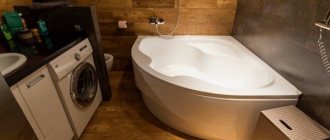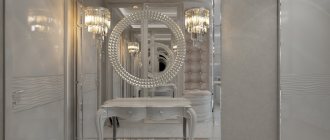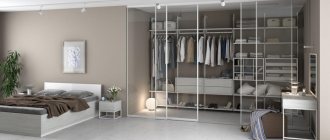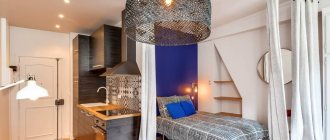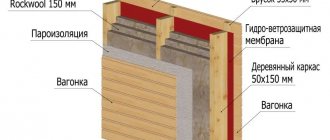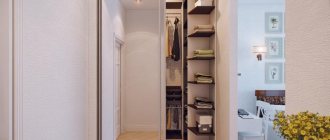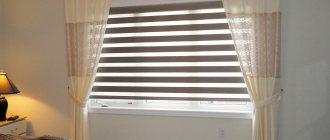Modern living spaces are distinguished by their original design, which involves a rather unusual combination of flooring materials with different structures and textures. One of the favorite techniques of designers is to combine laminate and tiles. This is perhaps the best option for zoning a living space.
When installing the final floor covering, it is often necessary to join the laminate and tiles. But no matter how hard you try, when uncovered, the joint is a gap with sharply defined boundaries, which does not look good on the new floor at all. To effectively hide it, special joining elements were invented - the so-called thresholds for laminate and tiles. Most often they are used when both flooring materials are laid in the same plane or the height difference is minimal - no more than 1 cm.
Features of attaching laminate to the wall
Any finishing material has its own installation features. For laminate they are as follows:
- It is a wear-resistant material that is not afraid of high loads and friction. However, for the floor they use this facing material of class A, that is, the largest in thickness and quite durable. There is no such need for walls. You can attach the thinnest laminate to the wall. After all, there won’t be such heavy loads on it;
- You cannot install laminated panels near batteries. Because exposure to hot air can have a bad effect on the coating and render it unusable;
- In almost all cases, before installing laminate flooring, you must first level the walls. However, with some fastening methods, this material, on the contrary, will help hide differences and other wall defects.
The main feature of attaching lamellas to the wall is their ease of installation. The home owner does not need to seek help from professional craftsmen. He can do the installation himself.
Laminate is a wear-resistant material that is not afraid of high loads and friction.
Tool for work
To cover walls with laminate, you will need some tools used for laying floors. There is no point in using them on the ceiling, because... everything is done there by weight. Click laminate strips can be precisely adjusted when laying using just a tool. It will not be possible to move them with your hands - the comb sits very tightly in the groove.
- Boss. Using a hammer, the strips are tapped through the boss as they are laid.
- Rule (emphasis on “and”), or hook. It is sometimes incorrectly called a clamp. The rule is to tighten the last strips, either by hand or by hitting the “flag” with a hammer.
- Spacer wedges maintain the indentation along the perimeter. You need at least two sets of wedges to work. Wedges are mainly used for flooring.
Advantages and disadvantages of laminate when finishing walls
Laminate when finishing walls is a unique material. It contains the following advantages:
- This material itself can give the walls a perfectly flat surface.
- It can be attached to the wall vertically, horizontally, in a herringbone pattern and continuously starting from the floor.
- Laminated panels can separate one workspace from another and enlarge a small room when installed correctly.
- The lamellas have good strength. Therefore, when hit, they will not break, unlike most other finishing materials.
- The panels are easy to maintain and do not require treatment with any chemicals.
- Laminated boards imitate wood or stone. They are safe for health and nature.
- The lamellas do not ignite, as they are treated with a special liquid.
- If defects are found, it can be disassembled and some parts renewed.
The panels are easy to maintain and do not require treatment with any chemicals.
In addition, this finishing material also has its disadvantages. For example:
- For some types of laminate flooring, the walls need to be leveled in advance;
- Almost all types of laminated panels do not like steam and liquid. They lose their aesthetic properties if installed in the bathroom or kitchen. There are, of course, moisture-proof boards, but they are more expensive;
- Sometimes laminate flooring fades greatly in the sun, so installing it opposite windows is not recommended.
Almost all types of laminated panels do not like steam and liquid.
Which one is better to choose?
There is no way to specifically answer this question, because the material is selected based on certain conditions. To choose a threshold, you need to know what function it will perform and how it will be mounted. Situations are different - you may need overlays, corners, maybe a special profile, or nothing but cork material will be needed.
If you choose a threshold from a specific material, it is important to know how often the floor element will be used. Wooden and plastic thresholds are most prone to wear and tear and must be replaced frequently. Metal products are not suitable for curved joints. In this case, you won’t find a better option than plastic thresholds to which rubber material has been added. They must heat up, be flexible, and take the required shape.
You need to select the threshold individually
Main types of laminate for walls
Laminate can be different and you need to choose it based on the purpose of the room, the design and style of the room, as well as the preferences of the owner. Below is a table including the main types of laminate and their characteristics.
Laminate can be different and you need to choose it based on the purpose of the room, the design and style of the room, as well as the preferences of the owner.
Laminate color options for walls
Laminates are also differentiated by color. Popular colors for wall decoration with laminated slabs are:
- Brown;
- Grey;
- White;
- Delicate pastel colors;
- Black;
- Blue;
- Pink.
Sometimes laminate flooring fades greatly in the sun, so installing it opposite windows is not recommended.
White
White laminate on the walls is used to visually increase the area of the room. In addition, it makes the room brighter. Therefore, it is installed in those rooms where there are few windows or the windows do not face the sunny side.
White laminate on the walls is used to visually increase the area of the room.
Grey
Most of all, gray laminate on the wall matches bright furniture and interior items. They stand out against the background, and the laminate acts as a neutral background.
Most of all, gray laminate on the wall matches bright furniture and interior items.
Light
Light laminated panels in pastel shades are most often used in bedrooms and children's rooms. Also, this material can be used in the living room or kitchen. It makes the space visually larger and brighter.
It makes the space visually larger and brighter.
Other possible options
Of course, not only laminate of the above colors is used in the interior. There are many others. For example, don't forget about brown. This is a classic and traditional shade that suits almost any style. It transforms any boring room into a stylish and cozy one. After all, brown color resembles the color of wood and imitates it.
This is a classic and traditional shade that suits almost any style.
Black laminated boards can also be used. They are used in loft, pop and hi-tech styles. The black shade makes the interior laconic and strict.
The black shade makes the interior laconic and strict.
Installation of a flexible threshold
To design a curved joint between laminate flooring and carpeting or tiles, a flexible T-shaped threshold for laminate flooring, 4 cm wide, is used. A similar product is sold in three-meter coils. Flexible thresholds for laminate flooring come in a variety of colors (about 15 shades), which makes it easier to select a model for joining floor coverings.
- On a clean floor (concrete base), a line where the surfaces meet is marked. It is advisable to adhere to the bend radius recommended by the manufacturers.
- The fastening profile is fixed along the marking line using a drill and screws.
- The flooring is being laid.
- The coil with the profile is placed in a container with hot water (40 -55 ˚C) for about 15-20 minutes.
- The flexible profile snaps into the fasteners. You only need to cut off the sill when it has cooled down.
A flexible threshold between tiles and laminate helps create smooth curved lines when zoning space.
Combinations of laminate wall finishing with other methods
Modern designers are not limited to one facing material. They combine other types of finishes with lamellas.
With wallpaper
Laminate goes well with walls covered with wallpaper. Typically the central wall is covered with laminated panels. All attention is focused on her. The remaining surfaces are finished with wallpaper that matches the style of the entire interior. This design is used in almost all styles, as it is universal.
Laminate goes well with walls covered with wallpaper.
With brick
The combination of brick with slats on the walls is typical for the loft style. The central wall can be made of either one or another material. Sometimes the floor of the wall is covered with laminate, and the floor is covered with brick-like clinker tiles.
Also, these facing materials are harmoniously combined in eco style. After all, both brick and laminate imitate natural materials.
The combination of brick with slats on the walls is typical for the loft style.
Other possible options
You can use plaster and laminate to decorate the walls. Then the room turns out to be laconic and cozy. Laminated panels are often laid on a wall that zones a room. The remaining walls are plastered and textured effects are added.
Sometimes only the small upper part of the wall is plastered, and the rest is finished with laminated boards that contrast in color with the plaster.
You can use plaster and laminate to decorate the walls.
Selecting Additional Items
It is very important to make the right choice of fasteners; the overall condition of the structure will depend on it. To fix the panels, clamps are usually used, which are inserted into the groove. When choosing them, it is necessary to take into account the thickness of the product being held - the thicker it is, the larger the diameter of the tongue should be.
Kleimer
Comparing clamps to other fastening materials, they cause less damage, whereas nails can split the board. Cleimers are available in two types: with a serrated tip and a flat one. The first one is driven into the panel with a tongue, and the second one presses the panel to the wall surface. Both elements are secured with small nails or screws.
Fastening with nails
When choosing liquid nails, it is necessary to consult what area of application they are designed for.
They are produced in two types: universal and for interior work. It is not recommended to cover walls made of dense laminate. That is why you should not use liquid nails to stick heavy objects. If the composition includes acrylic, then use at subzero temperatures is prohibited.
Design options for different rooms with laminate wall decoration
Laminate is a universal finishing material. Therefore, it can be used in almost any room. What design options with wall decoration with slats are available for rooms for different purposes are discussed below.
Laminate can be used in almost any room.
Living room
In the living room, laminated panels are used mainly for decorative purposes. They emphasize the main style of the room and can serve as a zoning element. For example, separate the place for relaxing and watching TV from the home library.
In the living room, laminated panels are used mainly for decorative purposes.
Kitchen
Laminate flooring for the kitchen must be coated with a special water-repellent solution. After all, this material is often mounted on the walls of the work area. Also, laminated panels are used to cover the wall that encloses the dining room and the place where food is prepared.
Laminate flooring for the kitchen must be coated with a special water-repellent solution.
Bedroom
The thinnest laminated panels are used in the bedroom. They are almost always installed at the head of the bed or on the wall opposite the bed. The remaining walls are covered with wallpaper or plaster.
The thinnest laminated panels are used in the bedroom.
Children bedroom
The most important thing for laminate in this room is its environmental friendliness and safety. In the nursery, you can harmoniously use laminated panels to separate the play area from the recreation or activity area. Sometimes large slabs are installed there, the installation of which produces as few seams as possible. In the future they can be used for drawing.
The most important thing for laminate in this room is its environmental friendliness and safety.
Hallway
They buy high-end laminate flooring for the hallway. After all, in this room it will often be subject to mechanical stress. Typically, laminated panels are mounted only on half the wall, and the rest is covered with wallpaper or textured plaster.
They buy high-end laminate flooring for the hallway.
Other possible options
The walls are also covered with laminate in other rooms. For example, in the attic or attic. Sometimes people use these spaces as a relaxation room. Therefore, the colors of the panels can be either calm or bright. A mix of such shades is often found.
The colors of the panels can be either calm or bright.
Corridor design: a combination of attractiveness and practicality
When decorating a hallway or corridor, preference is given to materials that are easy to care for.
Practicality of the material in any room
Since the walls here can often get dirty, laminate will be an effective solution. For finishing, you can, for example, decorate all the walls with panels or select only one of the walls.
The corridors are often narrow and sometimes poorly lit. To compensate for this drawback, it is better to prefer a fairly light coating - after all, it is still easy to maintain.
Design solution for wall decoration
But the gloomy corridor will take on a new life - it will become lighter and, as it were, even larger.
Laying laminate on the wall with your own hands step by step instructions
Laying laminate on the wall can be done in 3 different ways. It can be glued, secured to the sheathing, or installed using special fasteners. Step-by-step instructions for each method will be discussed below.
To glue laminated panels to the wall, you need:
- It is good to level the surface of the walls and prime them.
- Allow the walls to dry and check all laminate for shade and suitability.
- Only after a thorough check can you cut the lock from the end panel with a jigsaw. This lock is not needed there, as it only spoils the appearance of the installation.
- Next, “liquid nails” glue is applied to the entire first panel in winding strips.
- Now the plate is applied to the surface and pressed or slammed well. In this case, half a centimeter retreats from the corner.
- After this, you can measure the distance from the first panel to the floor, and cut the new slab according to the measurements taken.
- Next, the new panel is also glued with glue, just like the first one. If the lock is not cut, then the new and first panels are fastened together.
- If the master decides not to cut off the locks, then first he needs to connect all the panels of the second row together, apply glue to each, and only then attach it to the wall.
- If the locks are cut, then each panel must be glued one at a time.
When the walls are not particularly smooth, a method is used that involves the use of a frame. In this case, the frame is made of wooden or metal bars. The bars or profiles are installed 20-30 centimeters apart. The laminated panels are then nailed into place.
In the case of clamps, lathing is also needed. The only difference is that the slabs are nailed onto the frame not with nails, but with special fasteners, called clamps. These devices prevent damage to the laminate flooring and help correct errors during its installation.
Laminate can be glued, secured to the sheathing, or installed using special fasteners.
Purpose of thresholds
At first glance, this element is necessary only to improve the aesthetic component of the coating. But in practice, it performs a number of other, no less important functions. Timely installation of thresholds is not a labor-intensive process. Therefore, it is recommended to include them in the installation diagram and package in advance.
In practice, during the operation of the coating, a large amount of dust and dirt accumulates in the cracks formed by the two materials. It will take quite a bit of effort to remove it. By installing a connecting element, you can reduce the labor intensity of operating the floor. In addition to this factor, we note an improvement in the appearance of the coating.
Positive qualities of connecting elements:
- Durability of the coating. The most vulnerable areas of a decorative floor are the edges. Under constant mechanical load, chips and cracks form on their edges. Thresholds for laminate flooring between rooms will perform a protective function;
- Safety for residents while walking;
- Ability to hide small defects. Most often these are level differences between different floor coverings;
- A choice of various models, differing not only in appearance, but also in material of manufacture, design and installation method.
It is important to choose the right thresholds for laminate flooring with hidden fastenings or a similar model with a different installation diagram. To do this, you should familiarize yourself with their varieties.
Advice
The choice will be influenced not only by the operational, but also by the technical characteristics of this mounting component. In particular, it is necessary to correctly calculate the width in order to completely cover the transition from tiles to wood flooring.
Installation of thresholds on laminate and other materials is carried out in various ways:
- use of decorative thresholds;
- joint to joint;
- arrangement of podiums.
How to lay laminate flooring if the walls are uneven
Sometimes the owners of an apartment or house do not want to spend money on leveling the walls. Then you can cover the surface with laminate. The main thing is to know how to do it correctly.
In this case, a frame made of wooden blocks will help. They are mounted both vertically and horizontally. It happens that gaps form between the wall and the sheathing. Then it is necessary to install wooden linings in them.
Do not think that laminated boards can be glued to drywall. This is far from true. After all, laminate is a heavy material, and drywall may simply not withstand such a load.
Wooden blocks are attached both vertically and horizontally.
Materials
The market offers wooden, metal, laminated and plastic products, the variety of which will undoubtedly allow you to achieve an ideal combination with the chosen floor finishing option.
Wooden
Solid wood accessories look most natural on a natural wood floor. They can be matched to the coating material and form a single whole with it. The width of the products, regardless of the material from which they are made, is most often 20-60 mm. The length, according to manufacturers, starts with the standard width of a doorway with one leaf. Market research has shown that the size range of lengths of floor accessories for Polish manufacturers starts from 0.8 m, and for German ones - from 0.9 m. You can find products with a length of 0.93 everywhere; 1; 1.35; 1.8; 2; 2.1; 2.4; 2.7 m. Plastic products reach 3 and even 6 m.
How to properly care for the laminate surface after installation
In order for the laminate on the wall to retain its appearance for a long time, you need to properly care for it. Below are recommendations for its care:
- Once every 2 months you can wipe the walls with a damp cloth or sponge. There is no need to wet them too much, even if the panels are high-end;
- You can use household chemicals intended for laminated surfaces for cleaning;
- It is also possible to process the panels with a modern washing vacuum cleaner or steam generator;
- It is also permissible to use a mop with a soft pad when washing.
If stains are found on the surface of the slabs, it is better to immediately remove them with water or a cleaning agent. Otherwise, it will be much more difficult to remove such a stain in the future.
You can use household chemicals intended for laminated surfaces for cleaning.
Laying decorative rope
Another simple and affordable solution. You can purchase rope at any hardware store. The laying is carried out at the installation stage. After completion of the work, no manipulations are necessary.
There are other ways to design the ends. It is possible to use U-shaped edging panels and edge tape. Which method is suitable will depend entirely on personal preference.
Tips and tricks for laying laminate flooring
Professional finishers and designers advise you to listen to the basic recommendations for laying laminate flooring in different rooms. It is thanks to these tips that you can make the process of installing lamellas easy, and also correctly select this material for the interior of the room:
- Don't be afraid to experiment. Laminate is a material that can be laid in absolutely different ways; every time I come up with new layouts.
- Panels should be selected by class in accordance with the purpose of the room.
- There is no need to neglect the rules for caring for this material. This way it will last a long time.
- If a wooden frame is used in the installation, I first treat it with a fire-resistant compound.
- If there is high humidity in the room, then it is better to attach the laminate to the lathing. Otherwise, fungus may form in the space between the wall and the panels due to lack of ventilation.
Laminate is a material that can be laid in absolutely different ways; every time I come up with new layouts.
Laminate on the wall is always stylish and unusual. Such cladding will bring comfort, novelty and a special atmosphere to your home.
The influence of the direction of the board on the perception of the interior
Is the direction of the laminate coating important or not? Looking like natural wood, the material has the ability to influence our perception of a room.
Board placement influences perception
In this case, you can significantly “adjust” the parameters of the room that you don’t like – right down to the height of the walls and square footage.
Horizontal arrangement: “expanding” the walls
This technique allows you to visually expand. A horizontal arrangement is appropriate in rooms with high ceilings but a small area.
Visual expansion of walls is easy to do
In this case, the laminate is installed with a shift so that the joints are not located directly above each other, but, for example, in a checkerboard pattern.
What if the ceilings are low? In this case, the board is not sewn to the very top. When the entire space is filled, the proportions of the room change, and it begins to seem that the ceilings have become even lower.
Possible different installation options
Vertical arrangement: “raise” the ceiling
The vertical orientation of the laminate flooring creates the feeling of a high ceiling.
You need to pay attention to the brightness of the material
If the room has low ceilings, but is also narrow, then it is better to abandon this method of finishing.
Diagonal arrangement: choice for originals
This approach to installation allows you to use laminate flooring in any room. This method is complex and uneconomical, as it requires careful calculation and cutting of the material at an angle.
Choosing laminate to match the furniture
Only a master with relevant experience can perform the installation beautifully. This method is quite rare in design.

